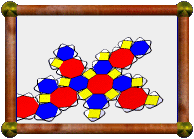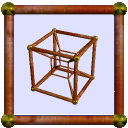 | Great Rhombidodecahedron |

- Vertex description: 10/3.4.10/7.4/3
- Faces: 42
- Edges: 120
- Vertices: 60
- External facelets: 612
- Dual: Great rhombidodecacron
This model is the dual of the great rhombidodecacron. It has 612 external
facelets, so expect this one to take a while! There are two squares and two
10/3 decagrams meeting at each vertex, in a butterfly pattern. It was a little
over a month between starting and finishing this model, but I didn't devote a
great deal of my time to it, so it could be finished much quicker. The
intricate cups are mostly one colour (using one colour per face type), so the
pieces join together well into bigger nets, which makes construction easier.
Sorry, no photos taken during construction this time because someone stole
my video camera! It goes together more easily than I expected when you get to
the end. I finished with a green piece.
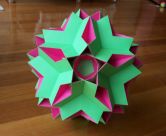
|
The view down a 5-fold rotational symmetry axes.
|
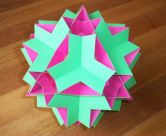
|
The view down a 3-fold rotational symmetry axes.
|
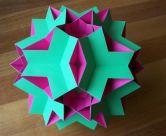
|
The view down a 2-fold rotational symmetry axes.
|
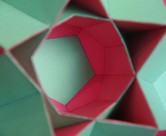
|
Here's a close-up shot of the detail in the model.
|
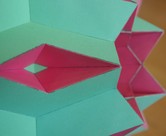
|
And another detail picture.
|
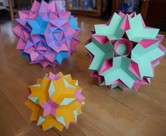
|
These three models are related to each other. They all share the same
set of vertices and edges. Four faces surround a vertex in each model,
and you may think of these as being two pairs, chosen from a set of
three available pairs: (1) a pair of decagrams, (2) a triangle and a
pentagram, and (3) a pair of intersecting squares.
The great dodecicosidodecahedron
has pairs (1) & (2).
The great rhombidodecahedron has pairs (1) & (3).
The great rhombicosidodecahedron
has pairs (2) & (3).
|
